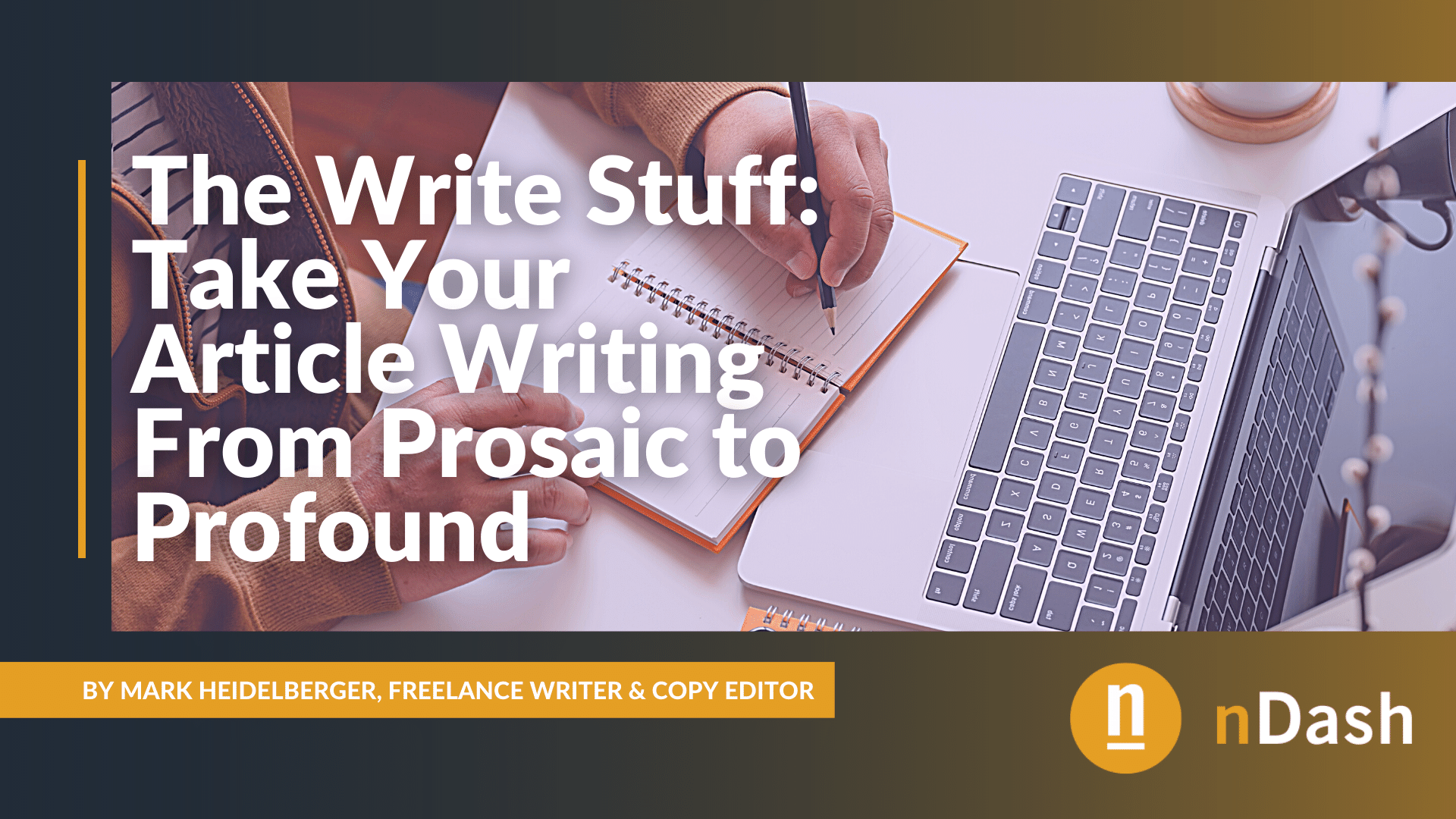What Are the Core Components of a Successful Article?
Did you ever write papers in college that you thought were home runs only to get them back mired in red ink?
- “What’s the main idea here?”
- “Paragraphs lack coherency.”
- “Conclusion is a non sequitur.”
- “Cite your source.”
According to a 2018 Journal of Technology and Science Education study, only 8% of students even came close to identifying the core elements of a good essay. So, it may be no wonder that poor practices continue their slow drip into the world of professional writing.
While many articles may ultimately prove informative, they often lack authority, credibility, profundity, and timelessness. The key to elevating your work lies in understanding the major elements of an article – title, introduction, main body, conclusion, and references. Understand their function, their relationship to each other, and how to maximize them.
Once you do this, demand for your writing services will increase dramatically. As such, consider the following tips and techniques for each element, designed to boost effectiveness and increase engagement with your intended audience.
The Five Core Components of a Successful Article
1: The Title
What makes a good title? First, does it offer some sort of promise? Will it fulfill a need? Maybe answer some burning questions? The best titles will. The title of this article offers the promise of information to better your writing.
There are three main types of titles:
- Descriptive: fairly neutral and does not reveal the article’s conclusions but simply expresses the nature of the topic.
- Declarative: asserts the main argument.
- Interrogative: poses the title as a question to be answered. Determine which one best fits your subject.
Know Your Audience and Tailor the Title to Them
For instance, I used more sophisticated words because I’m appealing to seasoned writers with expanded vocabularies. Across the board, titles should be clear, concise, and pithy (especially in this age of mass search results and short attention spans).
However, research articles may have longer titles due to the nature of their subject matter. Accuracy and precision are especially important for research articles, given the audience’s expectations.
Moreover, try to use keywords for indexing purposes if the article is meant for online readers, but be clever when possible, too. Note the double entendre inferred by my use of “Write” in my title. Pieces intended for print often allow more leeway for creativity since subscribers aren’t cold searching and have already shown a preference for the content source.
Choose Words That Convey the Article’s Tone
Is the piece deadly serious? Then make a declarative statement that lays out the consequences of ignoring the article’s findings. Or is it a bit tongue-in-cheek? If so, use puns or double meanings to generate humor. Your choice of words may also infer format like the following examples:
- Listicle: “Top 10 Food Sources of Vitamin A”
- Interview: “A Conversation with CEO Jack Smith”
- Instructional: “How to Cook Lobster”
2: The Introduction
Along with the title, the most important aspect for hooking readers is the introductory paragraph(s). This is where you establish the reader’s expectations for everything to follow. Fail to deliver on that promise, and you’ll lose them long before they reach the end.
Include a Thesis Statement
Make sure the intro sets up what the body will be about. Declare a thesis statement or question to be answered. I, for example, assert that applying the techniques herein will increase demand for your services. Arouse the reader’s curiosity by laying out an issue and then promising a solution. Like a good newspaper reporter, set up the who, what, when, where, how, and why.
Add Keywords
Again, use keywords, as search engine results often show prospective readers a snippet of the article section that involves their keyword search. What better place to hook them than a lucid intro?
Use Storytelling Techniques
Effective techniques include telling a story or anecdote to build rapport with the reader, incorporating a surprising fact, and (or) summarizing key points that will be addressed. Note that I did all three. I started with an anecdote about college that many people will empathize with, followed by a statistic that asserts a problem to be solved. I then summarize the article’s key elements and promise techniques to improve them.
3: The Main Body
Here is where you get into the details of the subject, as foreshadowed in the title and intro. You must give the reader your evidence and then analyze it. Write in the same style as the opening paragraph and back up assertions with data. (This is a critical element for research-oriented and scholarly pieces).
Logical Transitions
The logical flow of ideas from one paragraph to the next must be seamless. Fluid transitions are like ramps, simultaneously taking the reader out of one idea (up the ramp) and into another idea (down the other side). Determine the connective tissue that ties your ideas together – a theme, an argument, a data point – and use it to create coherency as you build your narrative.
List Formats
Listicles help makes transitioning between ideas easier because it breaks sections up by sub-topic. Still, there must be a logical flow, whether items are organized chronologically, alphabetically, by order of magnitude, or in some other way.
Also, avoid repetition except for stylistic purposes or as necessary to reinforce an idea. Keep introducing new ideas that continuously pique the reader’s interest.
Evergreen Content
Finally, try to use evergreen wording and facts to keep the article relevant for longer; the more evergreen, the more timeless. For instance, instead of saying, “When the Lusitania sank nearly 108 years ago,” say, “When the Lusitania sank in May of 1915….”
4: The Closing Summation
Close Your Article With a Clear, Concise Summary of the Arguments
This should be a single paragraph, usually pretty short (just a few sentences), also written in the same style as the rest of the article. Unlike the intro, where a thesis question is presented, the summation firmly answers the question posed by the thesis at the beginning.
Take All the Main Points of the Article and Pull Them Together
Don’t just repeat what you already stated in the body; show how the key points fit in conjunction. Note how I employ this technique at the end of this article.
One technique is to close with a new question that continues readership discussion of the topic. This is especially effective in online formats where readers can comment. For example, say your article closes with the argument that electric vehicles won’t seriously curtail atmospheric carbon until we can generate the majority of our electricity from renewables. In that case, you might close with, “So the real question is, what concrete steps can we take to transition our power grid to reliable and sustainable energy sources?”
5: References & Further Reading
The best articles are credible and authoritative. Cite reliable sources for any numerical data or fact-based assertions in the body of the article or at the end by using footnotes. Doing so increases the likelihood your article will be shared, published, cross-referenced, or cited by others.
Examples of reliable references include:
- prolific newspapers
- academic journals
- peer-reviewed studies
Generally, sites ending in .edu or .gov tend to be given more weight in critical circles.
If you’re questioning a source’s objectivity, look at who the author is and research the publisher. Then, ask yourself, “What is the purpose of this content? Why does it exist?”
Cross-Reference for Accuracy
To ensure accuracy, cross-check references against each other to see if key data points comport. This is particularly crucial in scholarly or research-oriented articles. A National Library of Medicine white paper states that “studies on the accuracy of references in various scientific disciplines demonstrate an error rate of 25%-54%.” Still, best practices like those previously mentioned can significantly reduce this.
Add a Further Reading Section
This section helps your audience continue their educational journey through other content that is a natural extension of your topic. For example, suppose you write an article on “The 5 Best Vacation Spots in the Southern Caribbean.” Then, the further reading might be a link to an article on “Excellent Hiking Trails in Barbados.” That link infers one of the reasons Barbados is on that list.
Let’s Recap: The Core Components of a Successful Article
In conclusion, a good article provides the reader with information, but a great article melds:
- a title that piques curiosity
- an introduction that clearly establishes a proposed thesis
- a main body that smoothly and effectively lays out evidence and analysis to support the thesis
- a conclusion that summarizes the key takeaway
- references that enhance credibility
This is what professional publications are searching for. The only question left now is, what do you want to write about?
Further Reading
- “5 Easy Tricks to Help You Write Catchy Headlines” by Jeff Goins
- “10 Simple Ways to Write Stronger Introductions” by Neil Patel
Become a Member of nDash for Blog and Article Writing Opportunities
Become a member of nDash’s community to connect with brands, see blog and article writing opportunities, and pitch ideas. Check out this help topic to learn how to get started and grow your freelance writing business: Getting Started.
About the Author
 With over 25 years of experience, Mark Heidelberger’s work has appeared on websites and publications like USA Today, Houston Chronicles’s Chron.com, C. Hope Clark’s Funds for Writers, and more. Check out his writer profile to learn more about how he can help take your content strategy to the next level: Mark Heidelberger.
With over 25 years of experience, Mark Heidelberger’s work has appeared on websites and publications like USA Today, Houston Chronicles’s Chron.com, C. Hope Clark’s Funds for Writers, and more. Check out his writer profile to learn more about how he can help take your content strategy to the next level: Mark Heidelberger.

